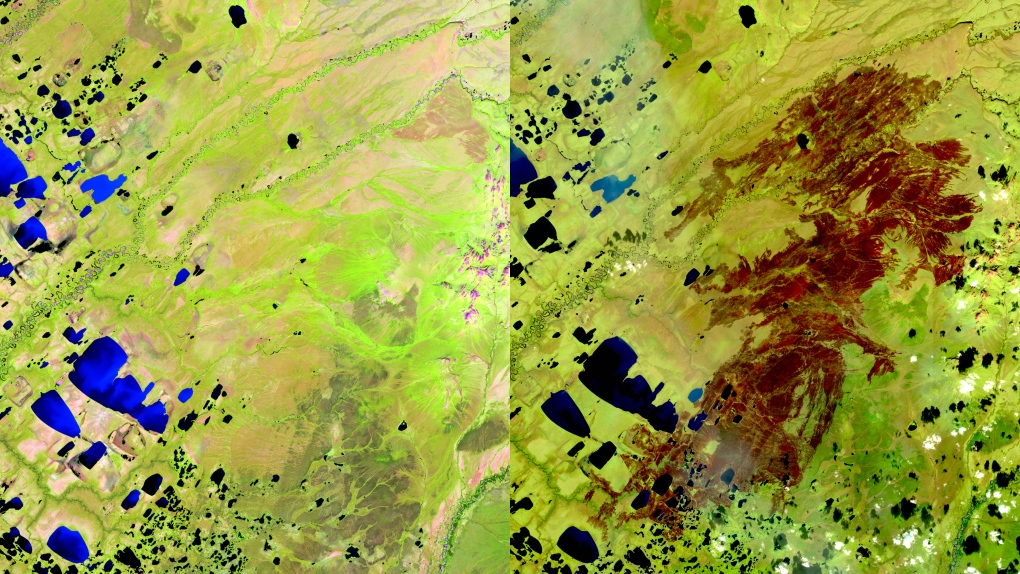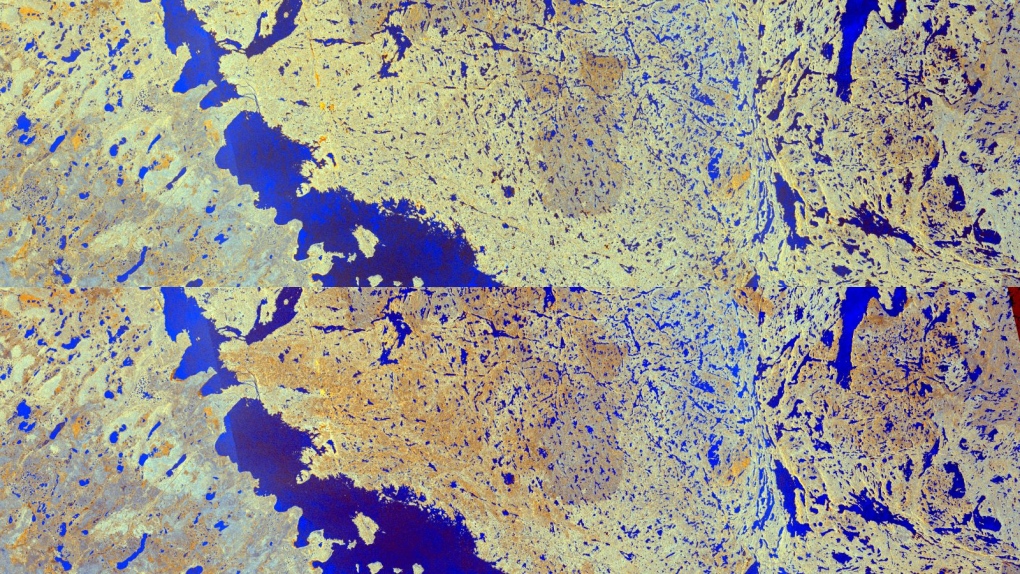
'The world is too messy for bureaucratic hurdles': Canada still bars Afghanistan aid
Ottawa has plans to finally stop blocking Canadian development aid to Afghanistan this year.
Images captured by satellite show that the damage left in the wake of some of Canada's worst wildfires.
Red-brown burn scars are clearly visible in the images provided to CTVNews.ca by the Canadian Space Agency in late September.
These "before" and "after" images were captured by the Sentinel-2 satellite, part of the European Union's Copernicus Program, and by the U.S. Geological Society's Landsat 8, as they travelled over British Columbia, Yukon and the Northwest Territories.
The "before" images show the areas as they were seen earlier in the summer: green from trees, grass and other plants. Photos captured when the satellite passed by later in the season and into the fall show burn scars, where the earth was scorched and plants burned.
Thousands of people were evacuated from their homes during what has been one of Canada's worst wildfire seasons to date. The scope of the fires made international news as smoke drifted past the country's borders, floating as far as Europe in some cases.
The Canadian Interagency Forest Fire Centre estimates that 6,474 fires have burned up approximately 18.1 million hectares of land this year – 181,000 square kilometres, or the equivalent of about 17 million CFL football fields.
The below images show some of the larger fires reported in Canada this year. The satellite images were processed by Dromadaire Geo-Innovations.
These images of the remote Old Crow area of Yukon were captured on July 10 and Sept. 13. A state of emergency was issued for Mayo, Yukon, and the surrounding area including Old Crow on Aug. 8.
 Image credit: Canadian Space Agency, contains Copernicus Sentinel satellite data (2023) processed by Dromadaire Geo-Innovations.
Image credit: Canadian Space Agency, contains Copernicus Sentinel satellite data (2023) processed by Dromadaire Geo-Innovations.
The photos show the natural colour, as seen from orbit.
The images below were captured through use of radar technology, and show the same area on July 7, compared to Sept. 1.
 Image credit: Canadian Space Agency, contains Copernicus Sentinel satellite data (2023) processed by Dromadaire Geo-Innovations.
Image credit: Canadian Space Agency, contains Copernicus Sentinel satellite data (2023) processed by Dromadaire Geo-Innovations.
These satellite images show the damage caused by fires in the Yellowknife area. The first was captured by the Copernicus Sentinel satellite on July 9. The second image shows the area as it appeared when the satellite passed by two months later, on Sept. 7.
 Image credit: Canadian Space Agency, contains Copernicus Sentinel satellite data (2023) processed by Dromadaire Geo-Innovations.
Image credit: Canadian Space Agency, contains Copernicus Sentinel satellite data (2023) processed by Dromadaire Geo-Innovations.
Images below were captured through with radar technology, and show the same area on July 6, compared to Sept. 16
 Image credit: Canadian Space Agency, contains Copernicus Sentinel satellite data (2023) processed by Dromadaire Geo-Innovations.
Image credit: Canadian Space Agency, contains Copernicus Sentinel satellite data (2023) processed by Dromadaire Geo-Innovations.
These sensor images captured by the Sentinel-2 show the areas of Hay River (first) and Enterprise, N.W.T., both of which were the sites of evacuations earlier this summer due to fires.
The first image of Hay River was captured on May 2, and is compared to a shot of the same area four months later.
 Image credit: Canadian Space Agency, contains Copernicus Sentinel satellite data (2023) processed by Dromadaire Geo-Innovations.
Image credit: Canadian Space Agency, contains Copernicus Sentinel satellite data (2023) processed by Dromadaire Geo-Innovations.
The Enterprise images were captured on Aug. 8 and Aug. 23, showing what a difference just two weeks can make.
 Image credit: Canadian Space Agency, contains Copernicus Sentinel satellite data (2023) processed by Dromadaire Geo-Innovations.
Image credit: Canadian Space Agency, contains Copernicus Sentinel satellite data (2023) processed by Dromadaire Geo-Innovations.
The Canadian Space Agency also included images captured with natural colour and shortwave infrared of the South Slave Lake region of the territory. These, captured on Aug. 28, show the smoke was significant enough to be visible from space.
 Image credit: Canadian Space Agency, contains Copernicus Sentinel satellite data.
Image credit: Canadian Space Agency, contains Copernicus Sentinel satellite data.
Parts of this area were evacuated as far back as May, with further evacuations rolling out through the summer. Firefighters are still today dealing with hot spots in some parts of the South Slave region, including in Enterprise, and in Fort Smith, where the fire danger forecast was high to extreme for the weekend.

Ottawa has plans to finally stop blocking Canadian development aid to Afghanistan this year.
Students protesting the Israel-Hamas war at at universities across U.S., some of whom have clashed with police in riot gear, dug in Saturday and vowed to keep their demonstrations going, while several school faculties condemned university presidents who have called in law enforcement to remove protesters.
A Sherwood Park family says their new house is uninhabitable. The McNaughton's say they were forced to leave the house after living there for only a week because contaminants inside made it difficult to breathe.
Hamas said Saturday it was reviewing a new Israeli proposal for a ceasefire in Gaza, as Egypt intensified efforts to broker a deal to end the months-long war and stave off a possible Israeli ground offensive into the southern Gaza city of Rafah.
State-sponsored actors targeted security devices used by governments around the world, according to technology firm Cisco Systems, which said the network devices are coveted intrusion points by spies.
It's one thing to say you like Taylor Swift and her music, but don't blame CNN's AJ Willingham's when she says she just 'oesn't get' the global phenomenom.
Although it's still unclear how much damage Robert F. Kennedy Jr.'s candidacy can do to either Joe Biden or Donald Trump this election, Washington political columnist Eric Ham says what is clear is both sides recognize the potential threat.
More than 115 people who viewed the solar eclipse in Ontario earlier this month experienced eye damage after the event, according to eye doctors in the province.
Russia launched a barrage of missiles against Ukraine overnight, in attacks that appeared to target the country's energy infrastructure. Meanwhile, Russia said its air defense systems had intercepted more than 60 Ukrainian drones over the southern Krasnodar region.

As if a 4-0 Edmonton Oilers lead in Game 1 of their playoff series with the Los Angeles Kings wasn't good enough, what was announced at Rogers Place during the next TV timeout nearly blew the roof off the downtown arena.
Mounties in Nanaimo, B.C., say two late-night revellers are lucky their allegedly drunken antics weren't reported to police after security cameras captured the men trying to steal a heavy sign from a downtown business.
A property tax bill is perplexing a small townhouse community in Fergus, Ont.
When identical twin sisters Kim and Michelle Krezonoski were invited to compete against some of the world’s most elite female runners at last week’s Boston Marathon, they were in disbelief.
The giant stone statues guarding the Lions Gate Bridge have been dressed in custom Vancouver Canucks jerseys as the NHL playoffs get underway.
A local Oilers fan is hoping to see his team cut through the postseason, so he can cut his hair.
A family from Laval, Que. is looking for answers... and their father's body. He died on vacation in Cuba and authorities sent someone else's body back to Canada.
A former educational assistant is calling attention to the rising violence in Alberta's classrooms.
The federal government says its plan to increase taxes on capital gains is aimed at wealthy Canadians to achieve “tax fairness.”